INSTITUT SUPERIEUR D'ANTHROPOLOGIE
INSTITUTE OF ANTHROPOLOGY
ONLINE COURSES / COURS A DISTANCE
WINTER TERM : JANUARY 2015
REGISTER NOW
EGYPTE – 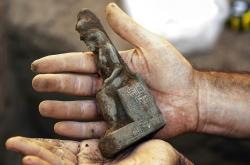 Karnak - Egyptian sources said that more statues are expected to be discovered as excavation operations are still taking place in the area. Among the newly discovered statues is one of an Egyptian goddess sitting on a throne and wearing the double crown and a limestone statuette of a Sphinx. “The 60-centimeter tall statue was discovered to the east of the sanctuary of the temple of God Ptah, one of the four main temple enclosures that make up the immense Karnak temple complex,” Karar told The Cairo Post Friday. It was discovered by archaeologists from the French-Egyptian Centre for the Study of the Karnak Temples, currently excavating at the northern area of the precinct of Amun-Re temple, according to Karar. “The statuette is in a good state of preservation and represents a lion’s body and the royal facial features of a Pharaoh, strongly believed to be of the New Kingdom Period (1580 B.C.-1080 B.C.),” said Karar adding that archaeologists are currently cleaning and examining the statuette for further historical details. Located with the large precinct of Amun-Ra at Karnak, the small temple of Ptah, approached from the west through five successive gateways, lies to the north of the main Amun-Ra temple, just within the boundary wall, archaeologist Sherif el-Sabban told The Cairo Post Friday. “The temple of God Ptah was built by Thutmose III, on the site of an earlier Middle Kingdom (2,000 B.C.-1,700 B.C.) temple and was later enlarged during the Greek Period (332 B.C.-30 B.C.),” said Sabban. Archaeologists from the French-Egyptian Center for the Study of the Karnak Temples have been studying the temple of Ptah Since October 2008, according to Sabban. In March 2012, they discovered a limestone gate engraved with the name of a Pharaoh called Sennakhtenre from the 17th Dynasty that launched the military campaign which rid Egypt of the tribe of invaders known as the Hyksos.
Karnak - Egyptian sources said that more statues are expected to be discovered as excavation operations are still taking place in the area. Among the newly discovered statues is one of an Egyptian goddess sitting on a throne and wearing the double crown and a limestone statuette of a Sphinx. “The 60-centimeter tall statue was discovered to the east of the sanctuary of the temple of God Ptah, one of the four main temple enclosures that make up the immense Karnak temple complex,” Karar told The Cairo Post Friday. It was discovered by archaeologists from the French-Egyptian Centre for the Study of the Karnak Temples, currently excavating at the northern area of the precinct of Amun-Re temple, according to Karar. “The statuette is in a good state of preservation and represents a lion’s body and the royal facial features of a Pharaoh, strongly believed to be of the New Kingdom Period (1580 B.C.-1080 B.C.),” said Karar adding that archaeologists are currently cleaning and examining the statuette for further historical details. Located with the large precinct of Amun-Ra at Karnak, the small temple of Ptah, approached from the west through five successive gateways, lies to the north of the main Amun-Ra temple, just within the boundary wall, archaeologist Sherif el-Sabban told The Cairo Post Friday. “The temple of God Ptah was built by Thutmose III, on the site of an earlier Middle Kingdom (2,000 B.C.-1,700 B.C.) temple and was later enlarged during the Greek Period (332 B.C.-30 B.C.),” said Sabban. Archaeologists from the French-Egyptian Center for the Study of the Karnak Temples have been studying the temple of Ptah Since October 2008, according to Sabban. In March 2012, they discovered a limestone gate engraved with the name of a Pharaoh called Sennakhtenre from the 17th Dynasty that launched the military campaign which rid Egypt of the tribe of invaders known as the Hyksos.
http://www.thecairopost.com/
MALTE – 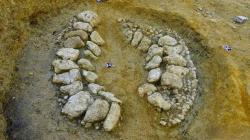 Gozo - Restoration work in the Citadella has unearthed a curious circular structure of hardstone pebbles set in blue clay. The structure might have been a fireplace or a burial structure however it is not yet known when it was built or for what. The structure is not a continuous circle as a recent trench for services cuts through it. The mysterious structure was discovered in the square in front of the Cathedral during EU-funded rehabilitation works on the Citadella. It will be preserved for future access once the site is paved as part of the project. The discovery was made last week during work on the rehabilitation of the square. The work is continuing but the authorities are considering ways how to preserve the discovery and make it accessible.
Gozo - Restoration work in the Citadella has unearthed a curious circular structure of hardstone pebbles set in blue clay. The structure might have been a fireplace or a burial structure however it is not yet known when it was built or for what. The structure is not a continuous circle as a recent trench for services cuts through it. The mysterious structure was discovered in the square in front of the Cathedral during EU-funded rehabilitation works on the Citadella. It will be preserved for future access once the site is paved as part of the project. The discovery was made last week during work on the rehabilitation of the square. The work is continuing but the authorities are considering ways how to preserve the discovery and make it accessible.
http://www.timesofmalta.com/articles/view/20141211/local/archaeologists-study-discovery-at-gozo-cathedral-square.547805?
GEORGIE – 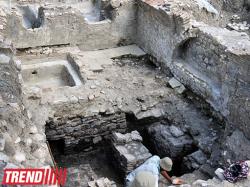 Shiraki - The satellite images from space have allowed Georgian archaeologists to discover an ancient settlement in Shiraki (Kakheti region, Eastern Georgia). The first phase of archaeological research will be completed in the coming days. Afterwards, we can talk about large-scale excavations. If the assumptions of archaeologists are confirmed, the discovered ancient settlement will completely change the history of the country, Ilia Chavchavadze Tbilisi University Professor Kote Pitskhelauri told reporters. According to one of the versions, the settlement dates back to the 10-12 centuries BC. It may be the capital of the ancient state, which is not mentioned in historical sources.
Shiraki - The satellite images from space have allowed Georgian archaeologists to discover an ancient settlement in Shiraki (Kakheti region, Eastern Georgia). The first phase of archaeological research will be completed in the coming days. Afterwards, we can talk about large-scale excavations. If the assumptions of archaeologists are confirmed, the discovered ancient settlement will completely change the history of the country, Ilia Chavchavadze Tbilisi University Professor Kote Pitskhelauri told reporters. According to one of the versions, the settlement dates back to the 10-12 centuries BC. It may be the capital of the ancient state, which is not mentioned in historical sources.
http://en.trend.az/scaucasus/georgia/2342303.html?
USA – 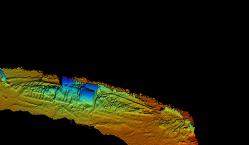 San Francisco - Feb. 22, 1901, in a dense morning fog, the SS City of Rio de Janeiro struck jagged rocks near the Golden Gate Bridge and sank almost immediately, killing 128 of the 210 passengers and crew aboard the ship. Fishermen in the area, hearing the ship’s distress calls, helped rescue 82 survivors, many plucked from makeshift rafts and floating wreckage. The dead included Chinese and Japanese immigrants as well as the U.S. Consul-General in Hong Kong, who was returning to the U.S. on leave with his wife and two children. The entire family died in the tragedy. NOAA’s Office of National Marine Sanctuaries Maritime Heritage Program is engaged in a two-year study to discover and document shipwrecks in Gulf of the Farallones National Marine Sanctuary and nearby Golden Gate National Recreation Area. California-based salvagers found the wreck in the 1980s, but its exact location was unknown as the coordinates they provided did not coincide with any wreck charted by NOAA through years of sonar work. During this expedition, Robert Schwemmer, West Coast Regional Maritime Heritage Coordinator, worked with Delgado and multibeam sonar expert Gary Fabian to locate the wreck site again. They located the site in 287 feet of water, positioned inside the main ship channel, and largely buried in mud. Schwemmer and the Hibbard team captured the first detailed sonar and three-dimensional images of City of Rio resting in the dark, muddy waters outside the bridge. The team also completed the first detailed map of S.S. City of Chester, which was rediscovered late last year in the vicinity of City of Rio. To see video of City of Rio, photographs and other materials, visit
San Francisco - Feb. 22, 1901, in a dense morning fog, the SS City of Rio de Janeiro struck jagged rocks near the Golden Gate Bridge and sank almost immediately, killing 128 of the 210 passengers and crew aboard the ship. Fishermen in the area, hearing the ship’s distress calls, helped rescue 82 survivors, many plucked from makeshift rafts and floating wreckage. The dead included Chinese and Japanese immigrants as well as the U.S. Consul-General in Hong Kong, who was returning to the U.S. on leave with his wife and two children. The entire family died in the tragedy. NOAA’s Office of National Marine Sanctuaries Maritime Heritage Program is engaged in a two-year study to discover and document shipwrecks in Gulf of the Farallones National Marine Sanctuary and nearby Golden Gate National Recreation Area. California-based salvagers found the wreck in the 1980s, but its exact location was unknown as the coordinates they provided did not coincide with any wreck charted by NOAA through years of sonar work. During this expedition, Robert Schwemmer, West Coast Regional Maritime Heritage Coordinator, worked with Delgado and multibeam sonar expert Gary Fabian to locate the wreck site again. They located the site in 287 feet of water, positioned inside the main ship channel, and largely buried in mud. Schwemmer and the Hibbard team captured the first detailed sonar and three-dimensional images of City of Rio resting in the dark, muddy waters outside the bridge. The team also completed the first detailed map of S.S. City of Chester, which was rediscovered late last year in the vicinity of City of Rio. To see video of City of Rio, photographs and other materials, visit
sanctuaries.noaa.gov/shipwrecks/city-of-rio-de-janeiro/
http://www.heritagedaily.com/2014/12/first-images-of-historic-san-francisco-shipwreck-ss-city-of-rio-de-janeiro-revealed/105951?
EGYPTE –  Assouan - Aswan’s Fatimid Cemetery, comprising tombs dating from the seventh to the 12th century A.D., was re-opened to the public after an eight-year renovation, according to the Egyptian Antiquities Ministry. The cemetery originally comprised 80 tombs, out of which 30 tombs still exist, while the rest have been lost due to urban expansion and the fragile materials -mud brick- used in constructing the tombs. “The Islamic necropolis in Aswan was originally built on an area of 1 square kilometer. Its northern part features four mausolea and several box-shaped tombs while the central part contains some mausoleums surrounded by numerous modest tombs. The southern part contains over 20 well-preserved mausoleums and groups of fenced-in modest tombs,” Islamic history professor Fathy Khourshid told The Cairo Post Sunday. The site is located nearby an ancient Egyptian granite quarry where an unfinished obelisk dating back to the reign of Queen Hatshepsut (1479 B.C.–1458 B.C.) was found, said Khourshid. “This explains the rose granite blocks used in the building of some tombs at the Islamic necropolis,” he added. According to Khourshid, the earliest tombstone in the area bears a name of a deceased person who was buried in 686 A.D., shortly after the Arab Conquest to Egypt while the last ancient tomb in the area bears a name of a someone buried toward the end of the 12th century, a few years before the fall of the Fatimid Caliphate.
Assouan - Aswan’s Fatimid Cemetery, comprising tombs dating from the seventh to the 12th century A.D., was re-opened to the public after an eight-year renovation, according to the Egyptian Antiquities Ministry. The cemetery originally comprised 80 tombs, out of which 30 tombs still exist, while the rest have been lost due to urban expansion and the fragile materials -mud brick- used in constructing the tombs. “The Islamic necropolis in Aswan was originally built on an area of 1 square kilometer. Its northern part features four mausolea and several box-shaped tombs while the central part contains some mausoleums surrounded by numerous modest tombs. The southern part contains over 20 well-preserved mausoleums and groups of fenced-in modest tombs,” Islamic history professor Fathy Khourshid told The Cairo Post Sunday. The site is located nearby an ancient Egyptian granite quarry where an unfinished obelisk dating back to the reign of Queen Hatshepsut (1479 B.C.–1458 B.C.) was found, said Khourshid. “This explains the rose granite blocks used in the building of some tombs at the Islamic necropolis,” he added. According to Khourshid, the earliest tombstone in the area bears a name of a deceased person who was buried in 686 A.D., shortly after the Arab Conquest to Egypt while the last ancient tomb in the area bears a name of a someone buried toward the end of the 12th century, a few years before the fall of the Fatimid Caliphate.
http://www.thecairopost.com/
ROYAUME UNI – 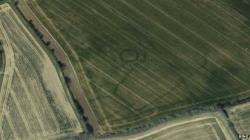 Wattisham - A metal detectorist has discovered a possible Bronze Age burial site while browsing on an aerial mapping website. Gary Campion, 48, was using Google Maps when he noticed dark circles and lines in a field near Wattisham in Suffolk. Suffolk County Council's archaeological service confirmed the markings were "very likely" to be mounds dating from the 3rd Century BC. The site is on private land and there were no excavation plans at the moment.
Wattisham - A metal detectorist has discovered a possible Bronze Age burial site while browsing on an aerial mapping website. Gary Campion, 48, was using Google Maps when he noticed dark circles and lines in a field near Wattisham in Suffolk. Suffolk County Council's archaeological service confirmed the markings were "very likely" to be mounds dating from the 3rd Century BC. The site is on private land and there were no excavation plans at the moment.
http://www.bbc.com/news/uk-england-suffolk-30434907?